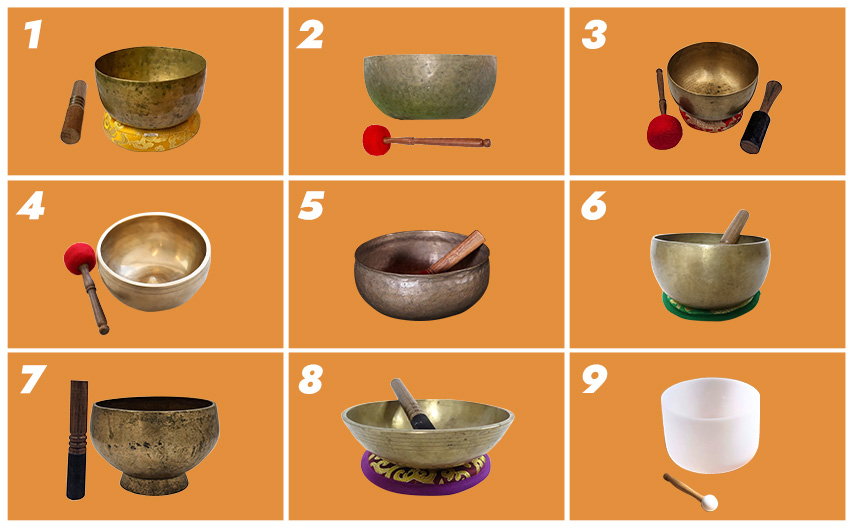Tibetan singing bowls are intriguing instruments that combine old traditions, spiritual healing, and artistic craftsmanship. These bowls are well-known around the world for their calming tones and rich history. Below, we look at nine different types of Tibetan singing bowls, diving into their distinct features, origins, and significance in diverse disciplines.
- Thadobati Singing Bowls
Features:
- The walls are straight, with a flat base.
- Generally engraved with etchings and inscriptions.
- Deep, resonant tones are produced.
Origins: Thadobati bowls are one of the oldest types which originally came from the Himalayas of Nepal and Tibet.
Importance: Because of the deep, rumbling chimes that come out, preferred for meditation and sound therapy, thus balancing the chakras and relaxation to the senses.
- Jambati Singing Bowls
Features:
- Wide, round shape with a flat bottom.
- Small and not heavy as other bowls.
- Low-frequency, powerful vibrations are emitted.
Origins: Their use is said to originate from the 17th century in various Himalayan monasteries and villages.
Importance: By emitting low frequency tones with resonant harmonics grounded to the Earth element for sound, offering perfect resonance sounds for grounding activities down to deeply profound meditation processes, which will provide much-wanted balance and serenity.
- Mani Singing Bowls
Features:
- Steeply formed walls and rim facing In
- Compact in size, hence light-weight
- Highly pitched clean tones
Origins: These bowls relate to Tibetan spiritual practices and get their name from the Buddhist mantra “Om Mani Padme Hum.”
Importance: Being widely used for chanting mantras and praying, their high overtones help in stimulating higher chakras to assist in keeping the mind clear.
- Lingam Singing Bowls
Features:
- The bottom of this bowl has a protrusion in the center, known as a “lingam”.
- Heavily decorated engravings.
- Produces both high and low tones.
Origins: These bowls come from the ancient traditions of Nepalese and are related to the Hindu and Buddhist theory of creation by gods.
Importance: These are the bowls unifying and spiritual growth implemented during the ceremonial occasions and states of deep meditation.
- Ultabati Singing Bowls
Features:
- Large deep shape with thick walls.
- Producing rich deep tones with long resonance.
Origins: The Ultabati bowls, originating from Nepal, have been produced for many centuries, most of them for healing ceremonies.
Importance: Famous for their healing vibration, these bowls release all the blockages of one’s emotion and help generate peace within through sound therapy.
- Remuna Singing Bowls
Features:
- Smoothening thin walls with gentle curves.
- It often features detailed etchings.
- Produces mid-range tones.
Origins: This bowl gets its name from a region in Nepal; generally, Remuna bowls are relatively modern compared to others.
Importance: Being balanced in tone, the bowls are good for the inward study of meditation and sound healing when one is a beginner.
- Naga Singing Bowls
Features:
- Two-piece construction.
- Unique shape, sort of chalice-like in presentation.
- Creates melodious high-pitched tones.
Origins: Linked to some tantric rituals and Buddhist ceremonies, Naga is rare to find.
Importance: They are used in spiritual offerings and rituals as a symbol of the connection between earth and spirit.
- Manipuri Singing Bowls
Features:
- Small, shallow shape with a wide opening.
- Light and portable.
- High, crystal clear tones.
Origins: Named after the Manipuri region, these bowls are among the oldest types, tracing their origin over a millennium ago.
Importance: Many times used for personal meditation and energy cleansing, easy to use and versatile, even by a beginner.
- Crystal Singing Bowls
- Made of quartz crystal rather than
- conventionally used metals.
- Appearance: transparent or frosted.
- Pure, ethereal tones it produces.
Origins: A modern take on bowls, these bowls find their place in the West, especially in sound healing modalities.
Importance: Conforming to modern energy healing, they amplify vibrations and hence are very effective in Chakra alignment and sound baths.
Conclusion
Each type of Tibetan singing bowl has a story to tell and is applied to some specific purpose that grew from ancient spiritual rituals to modern techniques of healing. You can choose the right bowl to enrich your meditation, therapy, or spiritual journey by understanding their features, origins, and importance.

